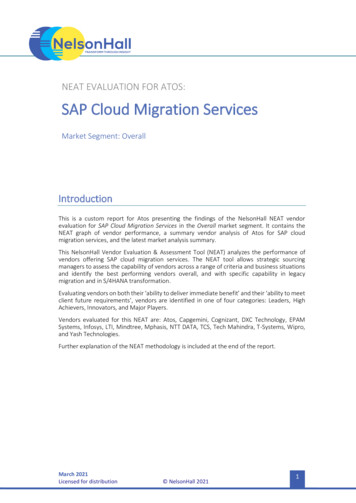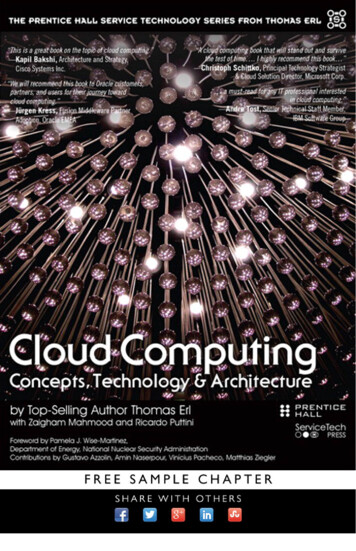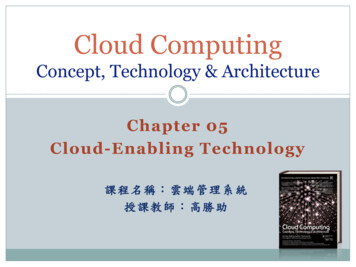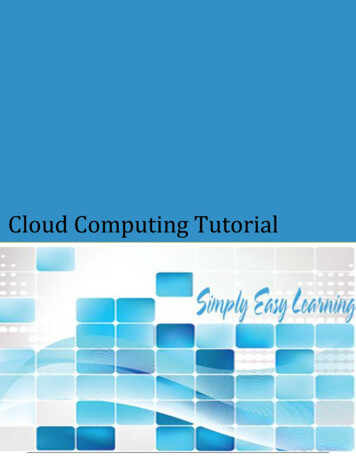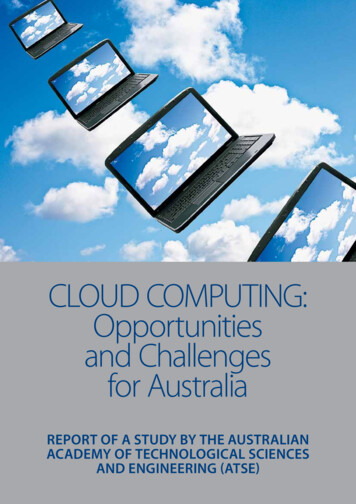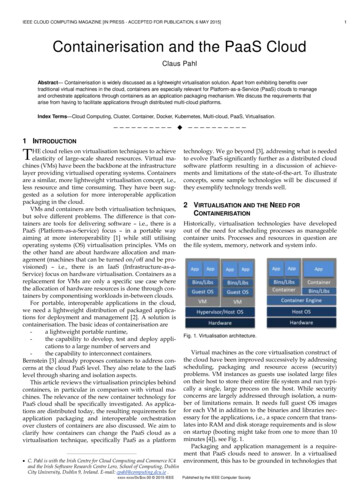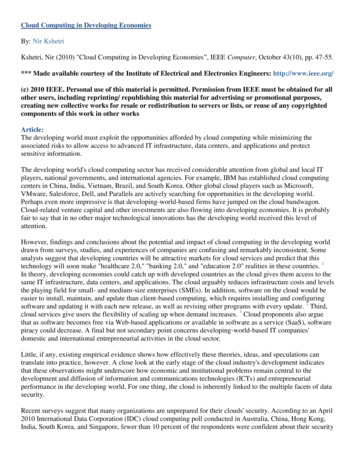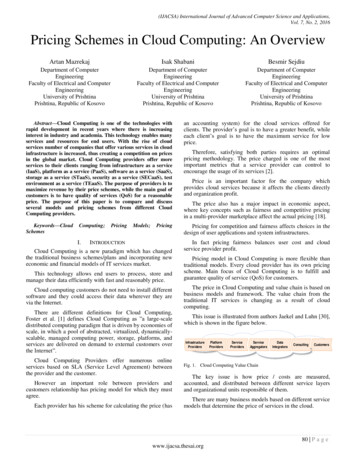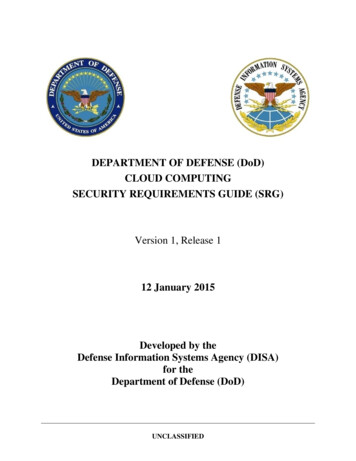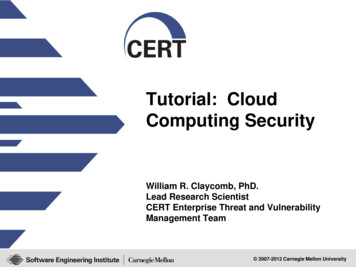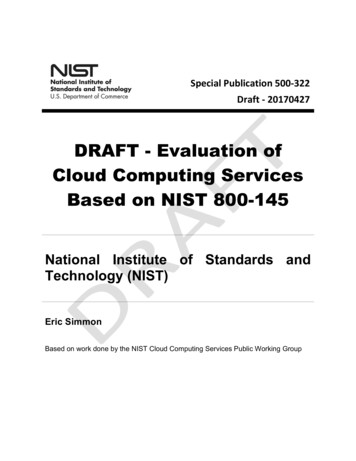
Transcription
Special Publication 500-322Draft - 20170427DRAFT - Evaluation ofCloud Computing ServicesBased on NIST 800-145National Institute of Standards andTechnology (NIST)Eric SimmonBased on work done by the NIST Cloud Computing Services Public Working Group
Evaluation of Cloud Computing Services Based on NIST 800-145This document provides clarification for qualifying a given computing capability as a cloud service bydetermining if it aligns with the NIST definition of cloud computing; and for categorizing a cloud serviceaccording to the most appropriate service model (SaaS, PaaS, or IaaS).AcknowledgementsNIST thanks the many experts in industry and government who contributed their thoughts to thecreation and review of this definition. NIST would like to acknowledgement the members of theNIST Cloud Computing Services Public Working Group listed below who worked many hoursproviding input for this document. A special thanks to Cary Landis who was the industry chairof the group.Cary Landis (Chair – NIST Cloud Computing Services Public Working Group)Ali Khalvati (GSA)Lalit Bajaj (GSA)Don Beaver (GSA)James YapleAngela RoweJames MooneyJames FowlerEugene LusterLarry LamersKeith Parker (ASI for GSA)Gary Rouse (VMSI for GSA)Travis FergusonChris FerrisKavya Pearlman1
Evaluation of Cloud Computing Services Based on NIST 800-145Contents1Introduction . 32The NIST Definition of Cloud Computing . 43Analysis of the Essential Characteristics of Cloud Computing . 64563.1On-demand self-service . 63.2Broad network access . 73.3Resource Pooling . 83.4Rapid elasticity . 93.5Measured service . 9Analysis of Cloud Service Models . 104.1Software as a Service (SaaS) . 114.2Platform as a Service (PaaS) . 124.3Infrastructure as a Service (IaaS) . 13Analysis of Cloud Deployment Models . 145.1Private Cloud Computing Service Deployment . 175.2Community Cloud Computing Service Deployment. 185.3Public Cloud Computing Service Deployment. 195.4Hybrid Cloud Computing Service Deployment . 19Worksheets . 206.1Cloud Service Worksheet . 206.2Cloud Service Model Worksheet . 216.3Cloud Deployment Model Worksheet . 227Example Cloud Service Marketing Terms . 228References . Error! Bookmark not defined.2
Evaluation of Cloud Computing Services Based on NIST 800-1451IntroductionThe Federal Cloud Computing Strategy1 characterizes cloud computing as a “profound economic andtechnical shift (with) great potential to reduce the cost of federal Information Technology (IT) systemswhile improving IT capabilities and stimulating innovation in IT solutions.” To promote the mission andeconomic benefits of cloud services, the Office of Management and Budget (OMB) issued a “Cloud First”policy to encourage the adoption of cloud computing services to gain new efficiencies and save money.The policy requires agency Chief Information Officers (CIOs) to implement a cloud-based servicewhenever there is a secure, reliable, and cost-effective option. The policy takes advantage of costsavings efficiencies that were described in several complementary and parallel United StatesGovernment (USG) initiatives, such as the 25 Point Implementation Plan to Reform Federal InformationTechnology Management.The National Institute of Standards and Technology (NIST), consistent with its mission,2 has a technologyleadership role in support of the USG secure and effective adoption of the Cloud Computing model3 toreduce costs and improve services. NIST was charged with the mission of developing a cloud computingtechnology roadmap and to lead efforts in developing and prioritizing cloud computing standards. TheNIST Cloud Computing Program (NCCP) created a series of public working groups on cloud computing togenerate input for the SP 500-291 NIST Cloud Computing Standards and Roadmap, and SP 500-293 NISTCloud Computing Technology Roadmap, Volume I and II. This document, hereafter referred to as “theRoadmap,” contains ten high-level priority requirements in security, interoperability, and portability forthe USG’s adoption of cloud computing.Requirement 4 of the Roadmap is for “Clearly and consistently categorized cloud services.” Thisrequirement is important to ensure that customers understand the characteristics of different types ofcloud services and are able to objectively evaluate, compare, and select cloud services suitable to meettheir business objectives.In the absence of clarification, organizations are at risk of adopting “services” that do not providecharacteristics of cloud computing. For example, some vendors reportedly decide to label theircomputing offerings as “cloud services,” even if the offerings do not support the essential characteristicsof a cloud service in the NIST definition.Furthermore, the frequent and common usage of the informal “aaS” suffix in marketing, as in “EaaS”,“DaaS”, and “STaaS” (often refered to as “XaaS” or “Everything as a Service”) is confusing, and(unintentionally) obfuscating the architecturally well-founded distinction of IaaS, PaaS, and SaaS. These“cloud service types” are generally coined by appending the suffix “aaS” after a type of computingcapability. This makes it difficult to determine whether something is a cloud service and has unintendedconsequence for organizations trying to satisfy their cloud-first objectives.To demystify the ambiguity surrounding cloud services, the NIST Cloud Computing Services PublicWorking Group analyzed the NIST cloud computing definition and developed guidance on how to use itto evaluate cloud services.1Office of Management and Budget, U.S. Chief Information Officer, Federal Cloud Computing Strategy, Feb. 8,2011. Online: tegy.pdf.2This effort is consistent with the NIST role per the National Technology Transfer and Advancement Act (NTTAA) of1995, which became law in March 1996.3NIST Definition of Cloud Computing, Special Publication 800-145, September 2011.3
Evaluation of Cloud Computing Services Based on NIST 800-145This document clarifies the cloud computing service models as published in NIST Special Publication (SP)800-145, The NIST Definition of Cloud Computing (NIST Definition, September 2011). The NIST Definitionwas intended for the stated purpose of “broad comparisons of cloud services and deploymentstrategies, and to provide a baseline for discussion from what is cloud computing to how to best usecloud computing.”4The clarification supports the proper planning for cloud migration, deployment, and retirement ofrelevant legacy systems. The GAO recommended in July 2012 that seven audited federal agencies shouldestablish estimated costs, performance goals, and plans to retire associated legacy systems for eachtype of cloud-based service as well as the same for retiring legacy systems, as applicable, for plannedadditional cloud-based services5.As this document is meant to provide guidance in understanding the categorization, evaluation,comparison, and selection of cloud services, it does not provide a prescriptive set of guidelines for theselection process. Instead, it uses the principles set forth in the NIST cloud computing definition as aframework for understanding a ccustomer’s requirements in a cloud computing context and thecapabilities offered by cloud service providers (CSP)s to enable easier decision making. The NIST cloudcomputing definition allows for flexibility in its interpretation and in many cases, the final decision relieson a mixture of objective and subjective perspectives.This document is intended for use by any stakeholder, including, but not limited to, buyers of IT andcloud services, IT managers, program managers, FedRAMP stakeholders, systems integrators, resellersof cloud services, etc.2The NIST Definition of Cloud ComputingNIST SP 800-145 was published in the fall of 2010. Since that time, the cloud computing environmenthas experienced a growth in technical maturity, yet the NIST Definition has retained a worldwideacceptance. This document provides an analysis of the NIST Definition of Cloud Computing based ontoday’s perspective and provides a methodology for evaluating services, complementing the NISTdefinition.NIST SP 800-145 provides a one sentence definition of cloud computing as “a model for enablingubiquitous, convenient, on-demand network access to a shared pool of configurable computing resources(e.g., networks, servers, storage, applications, and services) that can be rapidly provisioned and releasedwith minimal management effort or service provider interaction.” In addition, the NIST definitionintroduces the supporting concepts of three cloud service models, five essential characteristics, and fourtypes of cloud deployments.In total, the NIST Cloud Computing Definition is composed of 14 interrelated terms and their associateddefinitions:Core definition of the cloud computing model (above)Five essential characteristicso On-demand self-serviceo Broad network accesso Resource poolingo Rapid elasticityo Measured 00/592249.pdf4
Evaluation of Cloud Computing Services Based on NIST 800-145Three service modelso Software as a Service (SaaS)o Platform as a Service (PaaS)o Infrastructure as a Service (IaaS)Four deployment modelso Publico Privateo Communityo HybridFootnoted definition of “cloud infrastructure.”SP500-145 also includes multiple clarifying statements that are integrated into the text of the variousdefinitions. The NIST Definition makes use of additional terms that are clarified below:Application: Within the context of cloud computing, the term application may refer to either acloud-enabled SaaS, web or mobile application (e.g. Facebook), or an application that exists on avirtual machine (e.g., Linux application). It is therefore preferable to clarify that type ofapplication when using the term to avoid confusion.as a Service (aaS): The term “as a [cloud] Service” is a suffix describing a computing capabilitythat supports all five essential characteristics of cloud computing. The term “as a service (aaS)”implies that SaaS, PaaS, and IaaS are delivered by way of software.Cloud Infrastructure: The collection of hardware and software that enables the five essentialcharacteristics of cloud computing. The consumer of a cloud service does not manage or controlthe underlying cloud infrastructure. Cloud Infrastructure is represented in SP 500-292 NISTCloud Computing Reference Architecture (CCRA) within the ‘Resource Abstraction and Control’layer and Hardware layer.Cloud Service: A computing capability that is delivered as a service.Essential Characteristics: The five characteristics that must be available in a computingcapability to be qualified as a “cloud service.” They are listed here for clarity, but are discussedin greater details in Section 3.o on-demand self-service (see clause 3.1)o broad network access (see clause 3.2)o resource pooling (see clause 3.3)o rapid elasticity (see clause 3.4)o measured service (see clause 3.5)Multi-tenant: An architecture in which a single computing resource is shared but logicallyisolated to serve multiple consumers.Service Model: The highest-level categorization of cloud services as based on the type ofcomputing capability that is provided. Any given cloud service may be categorized as one ofthree service models, namely Software as a Service (SaaS), Platform as a Service (PaaS), orInfrastructure as a Service (IaaS).5
Evaluation of Cloud Computing Services Based on NIST 800-145This document uses an additional term “cloud service type” to describe informal terms often coined andused by industry by adding the suffix “aaS” after a computing capability, e.g., Email as a Service (EaaS).cloud service types are analyzed in Section 7 of this document.3Analysis of the Essential Characteristics of Cloud ComputingThis section provides a detailed analysis of the five Essential Characteristics of Cloud Computing foundabove. The approach was to decompose each characteristic to determine the primary criteria fordetermining if a computing capability is offered as a cloud service and the different options fordetermining whether the criteria is met.To understand the essential characteristics, it is important to understand the meaning of the term“essential.” In the context of SP 800-145 and this document, “essential” means each cloud serviceprovider (CSP) must have the capability to offer and to provide each essential characteristic to the cloudservice customer (CSC) for a given service. The CSC may or may not elect to implement or use eachessential characteristic in a specific instance. In addition, the CSC must make a subjective judgement todetermine if their requirements are fulfilled and to decide if the CSP’s offering can be considered a cloudservice for their purposes.The process of categorizing a computing capability is not always definitive because the requirements forthe service may vary by CSC. Therefore, this document allows flexibility in determining that a computingcapability qualifies as a cloud service by providing options for evaluating each capability.The options are described as “Option A” or “Option B,” where “Option A” is more objective, while“Option B” is more subjective and dependent on the specific requirements of the CSC. If a CSC choosesto use Option B instead of Option A, they must evaluate whether “Option B” meets their requirements,and the results are not comparable between CSCs with different requirements.Whether an entity can confirm a specific criterion is dependent on the criterion itself. Some criteria areexternally visible (such as availability) and can be confirmed by the CSC or other third party entity, whileother criteria (such as resource pooling) are internal to the cloud service and must be confirmed by theCSP.3.1On-demand self-service“A consumer can unilaterally provision computing capabilities, such as server time and networkstorage, as needed automatically without requiring human interaction with each serviceprovider.” – NIST Definition of Cloud ComputingPrimary CriteriaThe computing capability can be provisioned without humaninteraction with the service provider.Option A) Fully automated service provisioning (both the CSCinterface and the internal cloud infrastructure).Option B) The CSC uses an automated interface to requestand track the service, but the provider may use manuallabor to provision the service internally.Entity capable ofconfirming?The CSC can confirm it is either Option A or Option B but cannotdistinguish one from the other because they can only see the6
Evaluation of Cloud Computing Services Based on NIST 800-145provisioning interface, not the system behind the interface.Therefore, the CSP will confirm whether it is Option A or Option B.AdditionalClarificationBenefits3.2 The term consumer and CSC are used synonymously.Examples of “computing capabilities” include server time andnetwork storage. The term “Unilaterally” refers to the fact that the CSC initiatesthe service without human interaction with a human on the CSPside. The CSC organization may have a workflow processinvolving humans such as those for oversight and approval ofexpenditures, and the purchase can still be described asunilateral. The term automatically refers to automated provisioning. The question arose as to whether a ticketing system supportsthe requirement for automated provisioning. The CloudServices Working Group members suggest “yes,” as long as theprovisioning is fast enough to support CSC requirements asdescribed in the Service-Level Agreement (SLA). “As needed” access to computing capabilities.Broad network access“Capabilities are available over the network and accessed through standard mechanisms thatpromote use by heterogeneous thin or thick client platforms (e.g., mobile phones, tablets,laptops, and workstations).” – NIST Definition of Cloud ComputingPrimary CriteriaThe computing capability is available from a wide range of locationsusing standard protocols.Option A) Available over the Internet.Option B) Available over a network that is available from allaccess points the CSC requires.Entity capable ofconfirmingThe CSC or CSP can confirm Option A.AdditionalClarification Examples of thin or thick client platforms are mobile phones,tablets, laptops, and workstations. The phrase “thin or thick” is not included as primary criteriabecause it includes all clients.The CSC will confirm Option B (this is based on the CSC'srequirements for the cloud service).7
Evaluation of Cloud Computing Services Based on NIST 800-145 Benefits3.3 The term “standard mechanisms” implies that the computingcapability is available using standard protocols such of http,REST, TCP/IP, UDP, and/or other Internet protocols.The term “broad network” can apply equally to public, private,or hybrid clouds.Anytime anyplace access to computing resources from anymachine within policy and security constraints,Resource Pooling“The provider’s computing resources are pooled to serve multiple consumers using a multi-tenant model,with different physical and virtual resources dynamically assigned and reassigned according to consumerdemand. There is a sense of location independence in that the customer generally has no control orknowledge over the exact location of the provided resources but may be able to specify location at ahigher level of abstraction (e.g., country, state, or datacenter). Examples of resources include storage,processing, memory, and network bandwidth.” – NIST Definition of Cloud ComputingPrimary CriteriaEntity capable ofconfirmingAdditionalClarificationThe computing infrastructure is shared among more than one CSC.Option A) Two or more CSCs can share the cloud serviceresources using a
2 The NIST Definition of Cloud Computing NIST SP 800-145 was published in the fall of 2010. Since that time, the cloud computing environment has experienced a growth in technical maturity, yet the NIST Definition has retained a worldwide acceptance. This document provides an an
